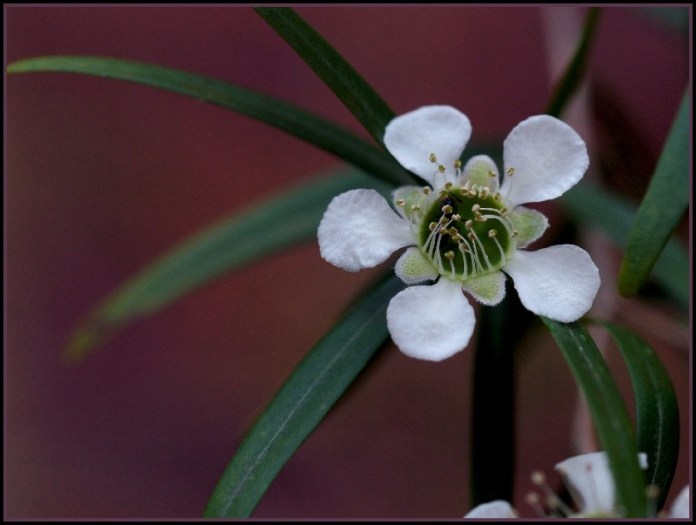Lemon-Scented Tea Tree
(Leptospermum petersonii)
Lemon-Scented Tea Tree (Leptospermum petersonii)
/
/

Tatters
CC BY-SA 2.0
Image By:
Tatters
Recorded By:
Copyright:
CC BY-SA 2.0
Copyright Notice:
Photo by: Tatters | License Type: CC BY-SA 2.0 | License URL: https://creativecommons.org/licenses/by-sa/2.0/ | Uploader: Tatters | Publisher: Flickr |




















Estimated Native Range
Summary
Leptospermum petersonii, commonly known as Lemon-Scented Tea Tree, is an evergreen shrub or small tree native to coastal rainforests and wet sclerophyll forests in Eastern Australia. It can grow up to 5 meters (16 feet) tall or more, with a bushy habit and dense foliage. The leaves, when crushed, emit a strong lemon scent due to the presence of essential oils. The white flowers, about 10–15 mm (0.39–0.59 in) in diameter, are solitary on short side shoots, with thin, papery, reddish-brown bracts at the base that typically fall as the bud develops. Flowering mainly occurs from December to January, and the fruit that follows is woody and inconspicuous.
Lemon-Scented Tea Tree is valued for its aromatic foliage and the white flowers that add a delicate touch to the garden. It is often used for hedges, windbreaks, and in aromatic gardens. The plant is also harvested for its essential oils, which are used in aromatherapy and perfumery. It thrives in full sun and requires medium amounts of water, preferring well-drained soils. Regular pruning can maintain it at shrub height, making it versatile for various landscape uses. While generally pest-resistant, it can be susceptible to scale insects and sooty mold. It is not known to be invasive when grown outside its native range, but gardeners should always monitor for unexpected spread.CC BY-SA 4.0
Lemon-Scented Tea Tree is valued for its aromatic foliage and the white flowers that add a delicate touch to the garden. It is often used for hedges, windbreaks, and in aromatic gardens. The plant is also harvested for its essential oils, which are used in aromatherapy and perfumery. It thrives in full sun and requires medium amounts of water, preferring well-drained soils. Regular pruning can maintain it at shrub height, making it versatile for various landscape uses. While generally pest-resistant, it can be susceptible to scale insects and sooty mold. It is not known to be invasive when grown outside its native range, but gardeners should always monitor for unexpected spread.CC BY-SA 4.0
Plant Description
- Plant Type: Shrub, Tree
- Height: 10-20 feet
- Width: 6-15 feet
- Growth Rate: Rapid
- Flower Color: N/A
- Flowering Season: Spring, Summer
- Leaf Retention: Evergreen
Growth Requirements
- Sun: Full Sun
- Water: Medium
- Drainage: Fast
Common Uses
Bee Garden, Bird Garden, Border Plant, Butterfly Garden, Deer Resistant, Drought Tolerant, Fragrant, Hedges, Low Maintenance, Salt Tolerant, Street Planting
Natural Habitat
Native to coastal rainforests and wet sclerophyll forests in Eastern Australia
Other Names
Common Names: Common Teatree
Scientific Names: , Leptospermum petersonii,
GBIF Accepted Name: Leptospermum petersonii F.M.Bailey